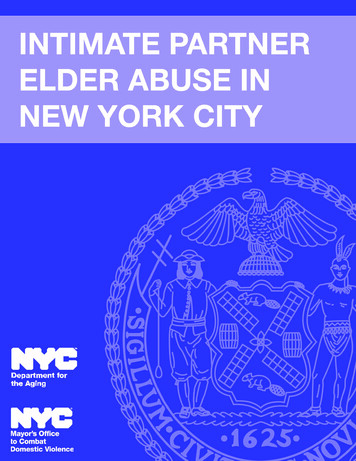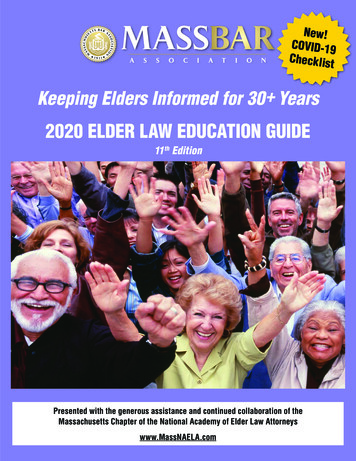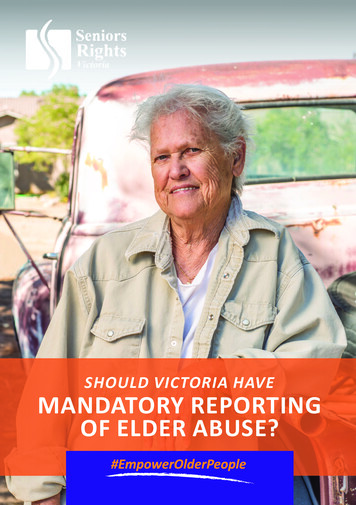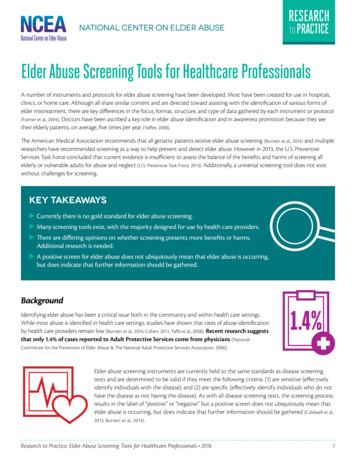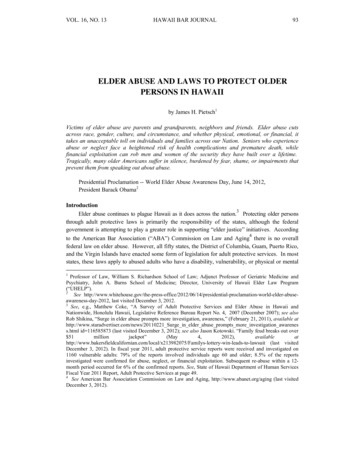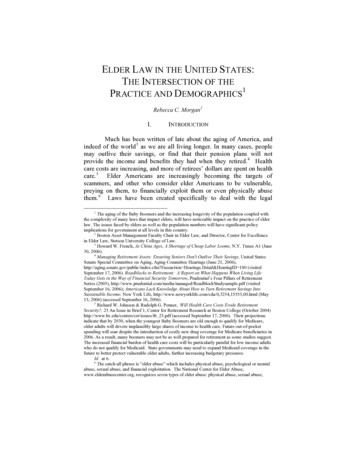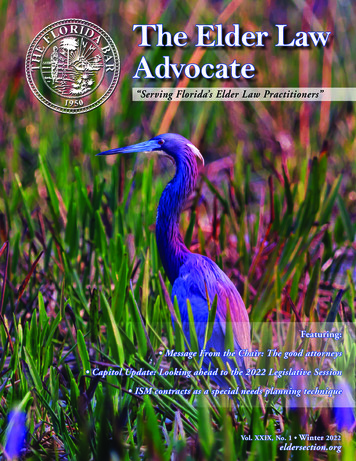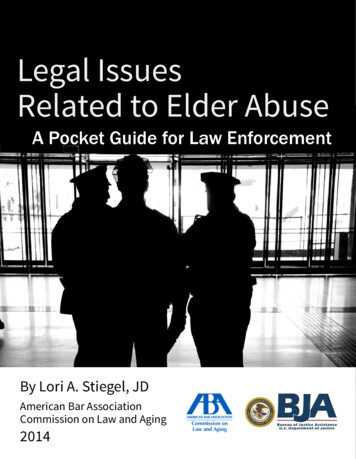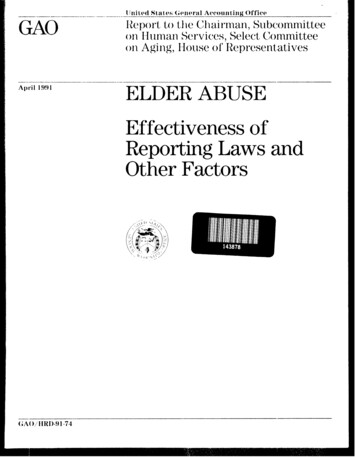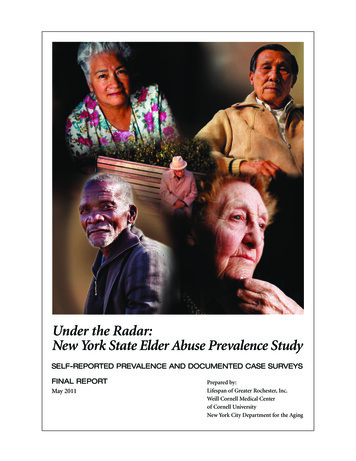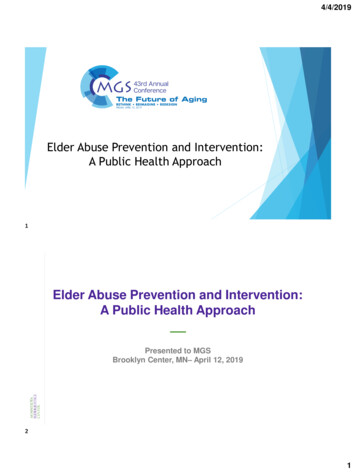
Transcription
4/4/2019Elder Abuse Prevention and Intervention:A Public Health Approach1Elder Abuse Prevention and Intervention:A Public Health ApproachPresented to MGSBrooklyn Center, MN– April 12, 201921
4/4/2019Welcome!Today, we will:› Review definitions and statistics› Discuss why elder abuse is a public health issue› Discuss Minnesota’s role› Explore themes and gaps› Introduce the Elder Justice Center› Share additional resources3Questions for you to consider› What would/could a state-wide public-healthresponse to elder abuse look like?› What policy changes/additions are needed to supporta state-wide public health response to elder abuse?42
4/4/2019Elder Abuse: toward a definition › Knowing, intentional or negligent act› Causes harm or serious risk of harm to anolder or vulnerable adult5Elder Abuse: toward a definition › Defined by age, relationship, type of abuse› Victims are often on a continuum from active tohaving various medical, cognitive, mobility issues› 2/3 of perpetrators of elder abuse are familymembers, trusted individuals and/or caregivers63
4/4/2019Prevalence› 1,000,000 – 2,000,000 adults in later life in U.S.are victims of abuse1› 1 in 10 persons over the age 60 are victims ofelder abuse2› Victims of elder financial abuse in U.S. loseclose to 3 Billion each year3123National Center of Elder Abuse:2005 Elder Abuse Prevalence and IncidenceNational Institute of Justice: Elder Abuse as a Criminal ProblemBlancato, Robert: Violence Against Older Women and The Elder Justice Act; 3/04/127Elder Abuse: Under the RadarFor every 1case of elderabuse thatcomes to theattention of aresponsibleentity another 23 casesnever come to light.Source: NYS Elder Abuse Prevalence Study; Weill Cornell Medical College, NYC Department for the Aging; Lifespan; (2011)Slide courtesy of Life Long Justice84
4/4/2019Growth of Older AdultsThe Administration on Aging expects thatby 2030, the U.S. population over age 65will have doubled from 2000, with olderadults representing 19% of thepopulation.9105
4/4/201911Why is Elder Abuse a Public Health Issue?› Health outcomes as consequences of elderabuse:› Increased Morbidity› Increased Mortality› Years of Potential Life Lost (YPLL)› Quality of Life (QOL)Centers for Disease Control126
4/4/2019Quality of Life› Declining functional ability› Increased dependency and sense of helplessness› Increased depression and psychological declineCenters for Disease Control13Costs to Society› Survivors of elder abuse have higher rates ofhospitalization and institutionalization› 5.3 Billion› Survivors have increased reliance on other publicprograms› 10 BillionACL 2018; Connolly 2014147
4/4/2019Types of Abuse› Domestic ViolenceLate in Life› Physical abuse› Emotional abuse› Sexual abuse› Spiritual abuse› Financial Exploitation› Neglect› Self Neglect15Poly-victimization› “Poly-victimization” refers to different formsof abuse occurring at the same time.› Between 10% and 40% of older adultsexperience polyvictimization.** Dong, X., Simon, M. A., & Gorbien, M. Elder abuse, neglect, and exploitation: Risk factors and preventionstrategies. Journal of Gerontological Social Work, 33, 5-25. (2007).168
4/4/2019› Isolation› Hints at being alone orafraid› Repeated “accidental”injuriesWarning Signs› Presents as “difficult”› Vague, chronic complaints› Unable to follow-throughon treatment plans;missed ng-2014.pdf17› Say they are “walking oneggshells”Warning Signs› Characterizes a loved one as“Dr. Jekyll and Mr. Hyde”› Makes veiled disclosures, e.g.“my son has a temper” or “Ihave to ask my daughter’spermission for everything”Safe Havens Interfaith Partnership Against Domestic Violence189
4/4/2019› Verbally abusive to the olderadult while charming toothersSomeonewho mightbe an abuser› Says things like, “she’sclumsy” “he’s juststubborn” “she doesn’tlisten” or “he’s so stupid”› Overly attentive to olderperson› Talks about the person as ifthey aren’t thereSafe Havens Interfaith Partnership Against Domestic Violence19› Controls activities andcontacts of the older adult› Portrays self as victimSomeonewho mightbe an abuser› Sabotages efforts to attendservices, meetings, evensand appointments› Threatens to harmthemselves or the olderadult or bothSafe Havens Interfaith Partnership Against Domestic Violence2010
4/4/2019Is it abuse?› You may not be able toobserve any of these redflags or the indicatorscould be explained byother causes.› Look for patterns orclusters of indicatorsthat suggest a problemSafe Havens Interfaith Partnership Against Domestic Violence21› Blames the victim:CommonAbuserJustifications› “She’s clumsy”› “He didn’t do what Iwanted.” (victim’sbehavior)› “She started it”(mutual abuse)› “He hit me when Iwas a child”(learned behavior)Safe Havens Interfaith Partnership Against Domestic Violence2211
4/4/2019CommonAbuserJustifications› “I have an angermanagement problem.”› “I was drunk,” or “I washigh”› “I’m sick; it’s not my fault”(physical or mental healthissue)› “In my culture, eldersshare their resources”› “He is too difficult for meto care for”Safe Havens Interfaith Partnership Against Domestic Violence23Reframing Caregiver Stress and Abuse› Everyone experiences stress. But mostdo not abuse› Abusers only target the older adult- notothers› Abusers tend to use caregiver stress asan excuse to create sympathy forthemselvesOVW, FLETC and NCALL (2012)2412
4/4/2019Minnesota’s Statutory Protections› Definition of “Vulnerable Adult”› Criminal Neglect› Financial Exploitation25Vulnerable Adult: Minn. Stat. 626.5572Categorical Definitions› Inpatient at a Facility› Receives services at or from a facility› Receives services from a home care provider, orperson that acts as a personal care/medical assistantFunctional Definition› Possesses a physical, mental, or emotionalinfirmity/dysfunction2613
4/4/2019Criminal Neglect: Minn. Stat. 609.233› Intentionally permit conditions that allowabuse/neglect› Knowingly fail to provide food, clothing, shelter,health care, supervision› Felony: substantial harm; or extended time27Financial Exploitation: Minn. Stat. 609.2335› Breach of fiduciary duty – i.e. Power of Attorney› Use of property for something other than the benefit of thevulnerable adult› Failure to use a vulnerable adult’s money or property fortheir benefit› Deprives vulnerable adult of their own financial resources2814
4/4/2019What is Supported Decision Making?› Supported Decision Making (SDM) is a philosophy thatacknowledges that people are happier and safer whenexercising the most autonomy of which they’re capable.› It’s an approach that maximizes individual agency, andminimizes external decision-making whenever possible.29› Cognitive Impairment› DenialWhy don’tvictims report?› Fear› Incredulity of others› Pride and desire to maintainautonomy› Shame or ing/pt barriers3015
4/4/2019› Desire to protect loved ones› Cultural boundariesWhy don’tvictims report?› Belief that institutional care isonly alternative› Depression and/or grief› Feelings of ng/pt barriers31Reporting Barriers: Social-Ecological Model PoliciesMisunderstanding of LawsAgeismSocial Norms Cultural BoundariesCommunity RelationshipsResource AvailabilityHistory of ViolenceRelationship FearDependencyDesire to Protect Loved OnesHistory of ViolenceIndividual Cognitive ImpairmentShame or EmbarrassmentDenialDepressionTechnologyFeelings of DeservednessSocietalCommunity3216
4/4/2019Abuse Intervention Model: Risk of Elder MistreatmentMosqueda, et al; J Am Geritr Soc 201633Abuse Intervention Model: Risk of Elder Mistreatment3417
4/4/2019Primary, Secondary, Tertiary Prevention35Elder Justice: Gaps in PH Response› CDC, NIH, private entities have spent billionsto develop public health responses to childabuse and domestic violence compared toelder abuse› Shortage of workforce trained to identify,address, prevent, and study elder abuseConnolly, 20143618
4/4/2019Elder Justice: Gaps in PH Response› 10x number of pediatricians v. geriatricians(2013)›Number of geriatricians declining›Most pediatricians trained on recognizing childabuse›Very few geriatricians are trained in recognizingelder abuseEldercare Workforce Alliance, 201337Needs› Data Collection/Research›Elder abuse research*:›NIA, 1.1 million (.0001% of budget)›CDC, 50,000 (.0008% of budget)›NIJ, 450,000 ( 1.2 million of DOJ funds)› Prevention and Intervention Programs›Evidence-based› Supportive Policy InfrastructureConnolly, 20143819
4/4/2019Elder Justice ThemesAgeism› Elder Abuse› Deterioration and paternalism› Spotlight on individual perpetrators and victims› Modern life is the problem› Everyone’s responsible/No one’s responsible› Surveillance and education› Other themes?39Elder Justice Policy ThemesOlder adults and poverty› Marketplace and cost-of-care› Financial Exploitation› Access to justice› Aging, race and disparities in QOL› Other themes?4020
4/4/2019Elder Justice Policy ThemesCriminal Justice Policy and Older Adults› System navigation and interaction between civil andcriminal justice systems› Investigations, responses, and court accessibility› Multi-disciplinary responses› Primary prevention and training› Other themes?41Elder Justice Policy ThemesCriminal Justice Policy and Older Adults› System navigation and interaction between civil andcriminal justice systems› Investigations, responses, and court accessibility› Multi-disciplinary responses› Primary prevention and training› Other themes?4221
4/4/2019VAA Through the Lens of PreventionMN Vulnerable Adult Act focuses on secondaryprevention43Questions for you!› What would/could a state-wide public-healthresponse to elder abuse look like?› What policy changes/additions are needed to supporta state-wide public health response to elder abuse?4422
4/4/2019MN Adult Abuse Reporting Center (MAARC)1-844-880-1574› 24-hour, toll free, state-wide› MAARC routes to appropriate investigative agency› Voluntary reports can be made anonymously45MN Adult Abuse Reporting Center (MAARC)2018 Data› Reports: 57,246› Allegations: 72,021› Caregiver Neglect32%› Self Neglect19%› Financial Exploitation 18%› Emotional Abuse16%› Physical Abuse12%› Sexual Abuse3%Data Source: MN DHS Data Warehouse4623
4/4/2019The Minnesota Elder Justice CenterMobilizing communities to prevent andalleviate abuse, neglect and financialexploitation of older and vulnerable adults.› Public Awareness› Professional Education› Public Policy› Direct Service47The Minnesota Elder Justice Center› We gave 130 different professional presentations across thestate Minnesota in 2018, from Thief River Falls to Worthington, andmany places in between. We reached close to 6,000 people in theseprofessional and community education efforts.› Social Work, Health Professions, Law Enforcement, JudicialBranch, Financial Institutions, Students› Community Education4824
4/4/2019The Minnesota Elder Justice Center› We provided assistance to at least 600 victims of elder abusein 2018, offering support, advocacy, systems navigation,guidance, links to services and legal referrals. This representsa 100% increase in victims served in 2017.49› MN World Elder AbuseAwareness DayConferenceSave the Date!› June 5, 2019› Earle Brown HeritageCenter, Brooklyn Park,MN5025
4/4/2019The Minnesota Elder Justice Center2019 Policy Priorities› Licensing Assisted Living Settings› Rights of Residents in LTC Settings› Funding Adult Protection Systems51Additional Resources5226
4/4/2019Society is like a building, we can improveit with support beams working togetherthat keep everyone safe!› Adult Protective Services› Advocacy Organizations› Law Enforcement› Financial Institutions› Medical Staff› Facility Staff› Concerned rgThank derjusticemn.org651-440-93005427
4/4/2019 4 Prevalence › 1,000,000 -2,000,000 adults in later life in U.S. are victims of abuse1 › 1 in 10 persons over the age 60 are victims of elder abuse2 › Victims of elder financial abuse in U.S. lose close to 3 Billion each year3 1National Center of Elder Abuse:2005 Elder Abuse Prevalence and Incidence 2 National Institute of Justice: Elder Abuse as a Criminal Problem
